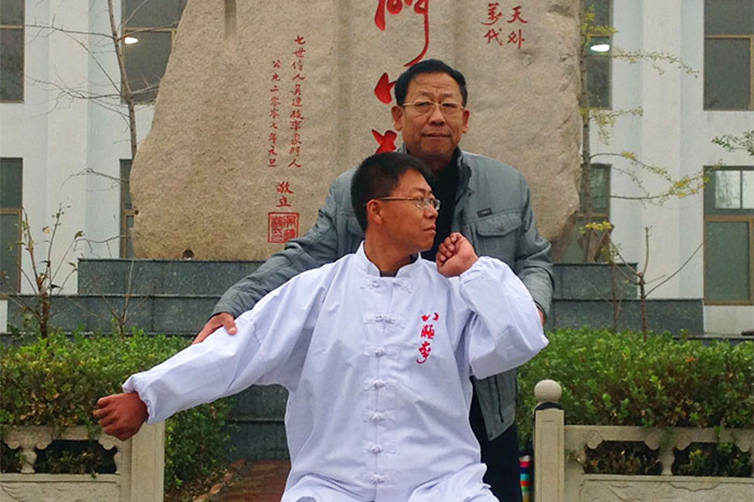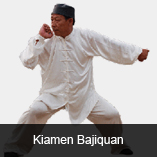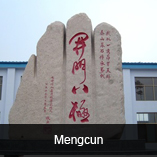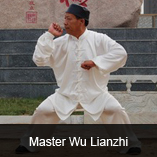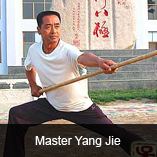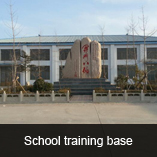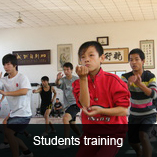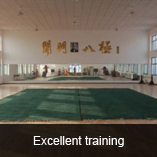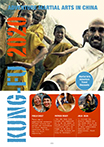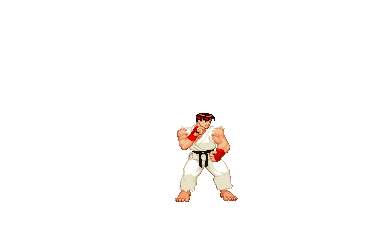Sanda (Sanshou) or ‘Chinese kickboxing’ has spread and evolved into a Chinese national sport. Sanda is a Chinese hand to hand combat self defense system and combat sport. As a sport Sanda has strict rules to ensure the safety of the two fighters during bouts. The rules prohibit attacks to the back of the head, spine or groin and discontinue combat when a fighter falls to the ground. However, many schools whether traditional or modern, or that practice Sanda for competing or not, practice it as an all round martial arts systems with no restrictions, only adapting their training in relation to competition rules prior to the event. Teaching and practicing techniques to restrain, maim, injure or kill an opponent or opponents. Sanda tournaments are one of the two sport wushu disciplines recognized by the International Wushu Federation.
Sanda or Sanshou is a synthesis of a few traditional Chinese kung fu fighting techniques into a more amorphous system and is commonly taught alongside traditional Chinese styles which Sanshou techniques, theory and training methods are derived from. The emphasis of Sanshou is on realistic fighting ability.
As an unarmed self-defense, close combat system, Sanshou includes da (punches), ti (kicks), shuai (grappling), and na (throws, locks, chokes). Sanda as a sport emphasizes throws in terms of point scoring. One of its most distinguished techniques is the "kick catch". This is when one person kicks and the person performing the throw catches the kick and then trips the person kicking. While kickboxing styles, such as Muay Thai also allow this, the kick catch is emphasized in Sanshou because of the importance it is given by the judges.
Baji Quan, is a traditional Chinese Marital Arts that features explosive, short range power. It originated in Hebei Province in Northern China, but is also well-known in other places today, especially Taiwan. Also known as "rake fist" due to the fist being held loosely and slightly open when not striking, resembling a rake. The term baji signifies “an extension in all directions" and in this case, it means “including everything" or “the universe." 'Ba' (Chinese for eight) denotes the eight major points of the body: head, shoulders, elbows, hands, buttocks, kua, knees, and feet and 'Ji' (polar) is extended in the eight polar directions. Bajiquan shares roots with another Hebei martial art, Piguazhang. It is said that Wu Zhong, the oldest traceable lineage holder in the Bajiquan lineage, taught both arts together as an integrated fighting system. They split apart, only to be recombined by Li Shuwen in the late 18th to early 19th century. As a testament to the complementary nature of these two styles, there is a Chinese martial arts proverb that goes: "When pigua is added to baji, gods and demons will all be terrified. When baji is added to pigua, heroes will sigh knowing they are no match against it." Bajiquan is characterized by direct, culminating and powerful fast strikes that will render an opponent unable to continue and is used in close combat, giving attention to elbow, knee, shoulder and hip strikes. When blocking an attack or nearing an opponent, Bajiquan techniques emphasize striking major points of vulnerability, the thorax (trunk of the body), the legs and neck. The major purpose of Ba Ji training is to develop ultimate snapping power with each strike and open the opponent's arms forcibly (Qiang Kai Men) and mount attacks at high, mid, and low levels of the body, or San Pan Lian Ji.
Six Major Characteristic Powers:
1. Sinking (Xia Chen or Chen Zhui)
2. Thrusting (Chong)
3. Extending (Cheng)
4. Entangling (Chan)
5. Crossing (Shi Zi)
6. Explosive and short (Cun)
The six big ways of opening the door or Liu Da Kai: is the most important practice of Baji
1. Ding: using the fist, elbow or shoulder to push forward and upward.
2. Bao: putting arms together as if hugging someone. It is usually followed by chop (Pi).
3. Ti: elevating the knee to hit the thigh of the opponent, or elevating the foot to hit the shin of the opponent etc.
4. Dan: using a single move.
5. Kua: using the hip.
6. Chan: entanglement with rotation around the wrist, elbow and shoulder
Stepping and Body Methods:
Footwork in Baji Quan has three special features: Zhen Jiao, Nian Bu and Chuang Bu. These striking techniques relate to ancient Chinese medicine, which states that all parts of the body are connected, either physically or spiritually.
Open Hand Forms and Weapons:
The forms of Baji are divided into Fist (non-weapon) and Weapon forms. There are 20 fist forms, which include 12 Baji Small Structure Fists, Baji Black Tiger Fist, Baji Dan Zhai, Baji Dan Da/Dui Da, Baji Luo Han Gong, and Baji Si Lang Kuan. There are eight weapons forms, including Liu He Da Qiang (spear), Liu He Hua Qiang (spear), Chun Yang Jian (sword), San Yin Dao (sabre), Xing Zhe Bang (staff), Pudao, and Chun Qiu Da Dao (a long two-handed heavy blade, used by Generals sitting on their horses).
Some of Baji's forms:
Black Tiger Fist, Small Frame 4th Road, Single Plucking, Small Frame 5th Road, Small Frame 3rd Road, Small Frame 6th Road, LoHan (Buddha's Disciple) Work, Small Frame 1st Road, Small Frame 2nd Road, Six Big Openings- Liu Da Kai, Pu Dao Plain Knife, Spring Autumn Big Knife, 6 Harmony Big Spear, Single Strike, Railing Hand Partner Set- Fu Shou, Si Lang Kuan, Pure Yang Sword, Raise the Willow Saber, Travelling Staff, Six Harmony Spear.
Pigua quan means "chop-hanging fist", also known as Piguazhang "chop-hanging palm" due to its emphasis on palm techniques, it is often practiced along with Baji quan. Piguazhang was a form of Kung Fu used when warriors wore armor and features explosive, long-range power.
It originated in Hebei Province in the North of China. Pigua quan's power is from the acceleration force of the arms which are often in rotation. The hip movement in Pigua quan is more subtle and gentle compared to Baiji quan because you only need enough to guide the big chops whereas in Baji quan, the hammer punches, elbows and swings rely completely on the quick and powerful rotation of the hips and sink to bring its power out.
It is often said that originally Baji quan and Pigua quan were the same art but split hundreds of years ago. Li Shu wen remarried the two systems in the late 19th to early 20th century and today these two styles are often taught as complementary arts. This is evident in the bridge forms which cross both styles. As a Chinese martial arts proverb states: When pigua is added to baji, gods and demons will all be terrified. When baji is added to pigua, heroes will sigh knowing they are no match against it.
In the practice of Piguazhang, the waist and the kua are employed as the centre of motion, and the torso, arms, and palm become an integrated moving body. Therefore, Piguazhang usually appears to contain large opening and closing movements, and the attacks are generally from a longer distance than Baji quan. In Piguazhang, striking with the front of the palm is called Pi, or hacking, splitting; striking with the back of the palm is called Gua, or hanging. These two types of palm strikes are used in an alternating and continuous manner like the turning of a wheel. In this motion, the dan tien area is used as the "controlling centre" for the store and the release of jings thus although the power generated in Piguazhang appears to be soft and round, a tremendous explosive force is actually hidden within it.
In 1928 when the well known and influential National Wushu Institute was formed a Pigua master of repute, Ma YingTu, was put in charge of the entire operation. One of his first acts was to invite Guo Changsheng, another Pigua practitioner from Hebei, to lecture at the institute. Together they did one of the first restructurings of Wushu not only streamlining the style, adding power moves but taking as inspiration the ancient actions of 24 Movement Tong Bei Quan (Through the Back Fist). Much of the Pigua now popular came from the efforts of these two men and the revised version they created, however much traditionally structured Pigua remains.
Piguazhang martial artists are known for their slow stance work but very fast hand motions. Arm strikes arrive from highly unusual angles often tracking to a "return" flight to reach their targets.
Pigua, also known as Long-Armed Ape Style, is truly unique in execution. The arms are move with such extreme looseness that practitioners often seem to have no bones. Because of this Pigua is particularly appropriate to female martial artists with high flexibility. Pigua, due to its loose arm flapping and extremely sinuous appearance is often said to resemble the animal actions of the Snake and the Eagle.
Wushu as a sport is both an exhibition and a full-contact sport derived from traditional Chinese martial arts. Created in the People's Republic of China after 1949, Wushu has spread globally through the International Wushu Federation (IWUF), which holds the World Wushu Championships every two years.
Wushu is composed of two disciplines: taolu (forms) and sanda (sparring). The forms are similar to gymnastics and involve martial art patterns and maneuvers for which competitors are judged and given points according to specific rules. The forms comprise basic movements, stances; kicks, punches, balances, jumps, sweeps and throws based on the aggregate categories traditional Chinese martial art styles and can be changed for competitions to highlight one's strengths. Competitive forms have time limits that can range from 1 minute, 20 seconds for external styles to over five minutes for internal styles.
Wushu Events:
• Bare handed: Changquan (Long Fist), Nanquan (Southern Fist) and Taijiquan (Taiji Fist)
• Short Weapons: Dao (Single edged sword), Jian (Double edged sword), Taijijian (Taiji double edged sword) & Nandao (Souther single edged sword)
• Long Weapons: Gun (Staff), Qiang (Spear) and Nangun (Southern Staff)
• Sanda: Sparring/Free Fighting
Most of the events were set up in 1958.
These events are performed using compulsory or individual routines in competition. Compulsory routines are those routines that have been already created for the athlete, resulting in each athlete performing basically the same set. Individual routines are routines that an athlete creates with the aid of his/her coach, while following certain rules for difficulty, number of acrobatics, etc.
Liu He Quan is an old style of Kung Fu rarely taught nowadays. It has, however, been influential in the formation and completion of many other styles.
The Six Harmonies Traditionally there are two pairs of six harmonious relationships comprising the Six Harmonies theory. One pair is known as The External Harmonies. It’s sister is called the Internal Harmonies. Before we consider them we should note that the Externals will actually contain six separate items, while the Internals will contain four items but parallel relationships. The Externals are paired relationships, the Internals are dependent relationships. This is just another level of sophistication derived from the philosophical base of the Liu He.
EXTERNAL Foot corresponds to Hand Elbow corresponds to Knee Shoulder corresponds to Hip
INTERNAL Mind leads Intent Intent leads Blood Blood leads Chi
http://www.plumpub.com/kaimen/2010/liu-he-six-harmony-boxing/
Tán Tuǐ (Chinese: 彈腿) is a famous Northern wushu routine and has several versions due to its incorporation into various styles. For this reason the name can be translated to mean "spring" or "springing leg" (the most popular) or "pond" or "lake leg".
Styles that incorporate Tán Tuǐ include Northern Praying Mantis, Chángquán, and Northern Shaolin as well as many other minor styles and systems.
Chāquán (Chinese: 查拳; Hanyu Pinyin: Zhāquán) is a Chinese martial art that features graceful movements and some acrobatic aerial maneuvers. Chāquán also includes a large range of weapons.
Chāquán falls under the classification Chángquán (literally "long fist"), a general term for external NorthernChinese martial arts, which are known for their extended, long movements.
Chāquán is associated with the Hui people. One famous master of Chaquan was the famous Wang Zi-Ping(Chinese: 王子平), who was known for his great strength. Other famous modern day masters include Zhang Wenguang, Ma Jinbiao, and Liu Hongchi.
Chāquán is one of the sources of the contemporary wǔshù Chángquán often seen in movies and tournaments. Chaquan is a system that has 6 main weapons(staff, saber, sword, spear, kwandao, hookswords).It emphasizes long range movements and stances combined with speed and power. The style includes many forms, including 10 lines of tantui for basic power training, 10 longer sets of chaquan, and other forms as well.
Taizu Chang Quan (Taizu Long Boxing) was invented by Zhao Kuangyin, Emperor Taizu of the Song dynasty. Widespread in the north of China, it gives full expression to the heroic characteristics of northern men when the whole set of boxing is exercised. Taizu Chang Quan has an expressive stance with particular emphasis on close cooperation and demonstration of hand-eye-body balance. Expressive and ebullient, elegant and awe-inspiring, Taizu Chang Quan boasts one of the six famous Quans (Boxing) in the Chinese martial arts circle.
